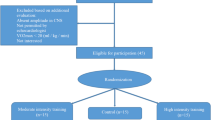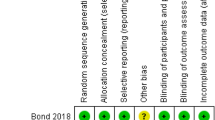Abstract
Purpose
The benefits of resistance training (RT) for migraineurs appears to be lacking although beneficial of aerobic training have been shown in previous studies. The aim of the current study, therefore, is to investigate the influence of RT on migraine headache indices, upper and lower-body strength, and quality of life (QOL) in women with migraine disorders.
Methods
Twenty female migraine patients who were referred by a neurologist were randomly assigned to two groups including RT group (n = 10) and control (CON) group (n = 10). The RT protocol consisted of 8 weeks, 3 sessions per week, 45–60 min per session. Visual Analog Scale (VAS) and pain diary were utilized to measure the subjects’ migraine indices including duration, pain severity, and frequency within 48 h pre- and post-training protocol. Patients in the Control group (CON) have been refrained from regular exercise during this study. The quality of life (QOL) and muscular strength were measured by the Headache Impact Tests (HIT) and one-repetition maximum (1RM) test, respectively, for 48 h pre- and post-training protocol.
Results
The RT resulted in a significant decrease in the migraine indices (headache intensity, frequency, and duration) (p = 0.02, p = 0.001, p = 0.04, respectivetly). Increased quality of life and chest and leg muscular strength significantly (p = 0.001 for all) were also showed after 8-week RT protocol. However, there were not any significant differences between groups considering, BMI and waist-hip ratio (WHR) after executing RT protocol (p > 0.05).
Conclusion
Based on the results of the current study that mainly had a positive trend, it could state that RT protocol with special consideration for migraine patients is probably an alternative therapy or augmentative complement to established interventions for migraine treatment.



Similar content being viewed by others
Availability of data and materials
All data are available and transparency.
Code availability
All data were analyzed using SPSS 22.0 statistical software and presented as means ± SD.
Abbreviations
- 1RM:
-
One-repetition maximum
- BMI:
-
Body mass index
- CGRP:
-
Calcitonin gene-related peptide
- CSD:
-
Cortical spreading depression
- DUR:
-
Duration
- FRQ:
-
Frequency
- HIT:
-
Headache impact tests
- ICHD:
-
International classification of headache disorders
- IHS:
-
International headache society
- INT:
-
Intensity
- QOL:
-
Quality of life
- RT:
-
Resistance training
- SED:
-
Sedentary
- VAS:
-
Visual Analog Scale
- WHR:
-
Waist to hip ratio
References
Durstine JL, Painter P, Franklin BA, Morgan D, Pitetti KH, Roberts SO (2000) Physical activity for the chronically Ill and disabled. Sports Med 30(3):207–219
Varkey E, Grüner Sveälv B, Edin F, Ravn-Fischer A, Cider Å (2017) Provocation of migraine after maximal exercise: a test-retest study. Eur Neurol 78(1–2):22–27
Varkey E, Cider A, Carlsson J, Linde M (2009) A Study to evaluate the feasibility of an aerobic exercise program in patients with migraine. Headache 49(4):563–570
Pairo Z, Parnow A, Sari-aslani P, Eslami R (2016) Effect of moderate intensity aerobic exercise on migraine headache indexes and quality of life improvement in women with migraine. Q Horiz Med Sci 22:291–297
Busch V, Gaul C (2008) Exercise in migraine therapy—is there any evidence for efficacy? A critical review. Headache 48(6):890–899
Eftekhari S, Edvinsson L (2010) Possible sites of action of the new calcitonin gene-related peptide receptor antagonists. Ther Adv Neurol Disord 3(6):369–378
Varkey E (2012) On the prevention of migraine-focus on exercise and the patient’s perspective. University of Gothenburg, Gothenburg
Hindiyeh NA, Krusz JC, Cowan RP (2013) Does exercise make migraines worse and tension type headaches better? Curr Pain Headache Rep. https://doi.org/10.1007/s11916-013-0380-5
Schwartz JS, Song P, Blitzer A (2007) Headache. Therapeutic uses of botulinum toxin. Humana Press, pp 91–108
Gil-Martínez A, Kindelan-Calvo P, Agudo-Carmona D, Muñoz-Plata R, López-de-Uralde-Villanueva I, La Touche R (2013) Therapeutic exercise as treatment for migraine and tension-type headaches: a systematic review of randomised clinical trials. Rev Neurol 57(10):433–443
Totzeck A, Unverzagt S, Bak M, Augst P, Diener HC, Gaul C (2012) Aerobic endurance training versus relaxation training in patients with migraine (ARMIG): study protocol for a randomized controlled trial. Trials. https://doi.org/10.1186/1745-6215-13-46
Eslami R, Parnow A, Pairo Z, Nikolaidis P, Knechtle B (2021) The effects of two different intensities of aerobic training protocols on pain and serum neuro-biomarkers in women migraineurs: a randomized controlled trail. Eur J Appl Physiol 121(2):609–620
Barber M, Pace A (2020) Exercise and migraine prevention: a review of the literature. Curr Pain Headache Rep 24(8):1–7
Parnow AH, Gharakhanlou R, Eslami R (2012) Effects of physical activity on calcitonin gene-related peptide content at trigeminal ganglion nerve in wistar rats. J Mazandaran Univ Med Sci 22(90):25–31
La Touche R, Fernández Pérez JJ, Proy Acosta A, González Campodónico L, Martínez García S, Adraos Juárez D et al (2020) Is aerobic exercise helpful in patients with migraine? A systematic review and meta-analysis. Scand J Med Sci Sports 30(6):965–982
Song T-J, Chu MK (2021) Exercise in treatment of migraine including chronic migraine. Curr Pain Headache Rep 25(3):1–11
Faul F, Erdfelder E, Lang A-G, Buchner A (2007) G* Power 3: A flexible statistical power analysis program for the social, behavioral, and biomedical sciences. Behav Res Methods 39(2):175–191
Marchese R, Taylor J, Fagan K (2019) The essential guide to fitness: for the fitness instructor. Cengage Learning, Australia
Brzycki M (1989) A practical approach to strength training. Masters Press, Grand Rapids, MI
Yang M, Rendas-Baum R, Varon SF, Kosinski M (2011) Validation of the Headache Impact Test (HIT-6TM) across episodic and chronic migraine. Cephalalgia 31(3):357–367
De Wilde JA, Van Dommelen P, Middelkoop BJC (2013) Appropriate body mass index cut-offs to determine thinness, overweight and obesity in South Asian children in The Netherlands. PLoS ONE 8(12):e82822
Amin FM, Aristeidou S, Baraldi C, Czapinska-Ciepiela EK, Ariadni DD, Di Lenola D et al (2018) The association between migraine and physical exercise. J Headache Pain 19(1):83
Misra UK, Kalita J, Tripathi GM, Bhoi SK (2013) Is β endorphin related to migraine headache and its relief? Cephalalgia 33(5):316–322
Köseoglu E, Akboyraz A, Soyuer A, Ersoy AÖ (2003) Aerobic exercise and plasma beta endorphin levels in patients with migrainous headache without aura. Cephalalgia 23(10):972–976
Krøll LS, Hammarlund CS, Linde M, Gard G, Jensen RH (2018) The effects of aerobic exercise for persons with migraine and co-existing tension-type headache and neck pain. A randomized, controlled, clinical trial. Cephalalgia 38(12):1805–1816
Darabaneanu S, Overath CH, Rubin D, Lüthje S, Sye W, Niederberger U et al (2011) Aerobic exercise as a therapy option for migraine: a pilot study. Int J Sports Med 32(6):455–460
Jackson W, Zale EL, Berman SJ, Malacarne A, Lapidow A, Schatman ME et al (2019) Physical functioning and mindfulness skills training in chronic pain: a systematic review. J Pain Res 12:179–189
Daenen L, Varkey E, Kellmann M, Nijs J (2015) Exercise, not to exercise, or how to exercise in patients with chronic pain? Applying science to practice. Clin J Pain 31(2):108–114
Irby MB, Bond DS, Lipton RB, Nicklas B, Houle TT, Penzien DB (2016) Aerobic exercise for reducing migraine burden: mechanisms, markers, and models of change processes. Headache 56(2):357–369
Bigal M, Krymchantowski AV, Lipton RB (2009) Barriers to satisfactory migraine outcomes. What have we learned, where do we stand?: Views and perspectives. Headache 49(7):1028–1041
Acknowledgements
We sincerely thank the subjects for their dedication and participation in this study. We also gratefully acknowledge the technical assistance of Ph.D. students to monitor in practical training, Mrs. Zahra Pairo, Ms. Afsaneh Astinchap, and Ms. Jaleh Amirian.
Funding
This work was supported by the Medical Sciences University, Kermanshah, Iran (No. 1394.15).
Author information
Authors and Affiliations
Contributions
AP contributed to designing research and final edition, MA contributed to the literature search, training the subjects, and data collection. OR contributed in preparing the manuscript, BK contributed in discussion preparation, and, PS contributed as supervisor and Neurologist to Migraine patients.
Corresponding author
Ethics declarations
Conflict of interest
All authors declare no conflicts of interest.
Ethical approval
The Medical Ethics Committee formally approved this research, Medical Sciences University, Kermanshah, Iran (ethical code: IR.kums.rec.1394.15), and it was registered at the Iranian Registry of Clinical Trials (IRCT2015100910824N2).
Consent to participate
All patients were requested to fill out the consent form.
Consent for publication
All authors are consent to publish the manuscript.
Additional information
Publisher's Note
Springer Nature remains neutral with regard to jurisdictional claims in published maps and institutional affiliations.
Rights and permissions
About this article
Cite this article
Sari Aslani, P., Hassanpour, M., Razi, O. et al. Resistance training reduces pain indices and improves quality of life and body strength in women with migraine disorders. Sport Sci Health 18, 433–443 (2022). https://doi.org/10.1007/s11332-021-00822-y
Received:
Accepted:
Published:
Issue Date:
DOI: https://doi.org/10.1007/s11332-021-00822-y




